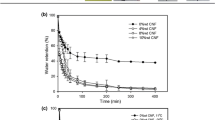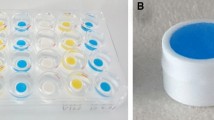Abstract
Intelligent hydrogels with multifunctions including biocompatibility, good mechanical property, photothermal property, sustained drug delivery ability, and antibacterial property are urgently needed in the biomaterial fields. Herein, mesoporous polydopamine (MPDA) nanoparticles were wrapped by polyethyleneimine-modified cellulose nanocrystals (PCNC) and then physically crosslinked in cellulose nanofibrils (CNFs) hydrogel, obtaining a novel MPDA@PCNC/CNFs composite hydrogel with a double packing structure for controlled drug release. Tetracycline hydrochloride (TH) was selected as the drug model and it was loaded on MPDA nanoparticles. PCNC was warped outside surface of MPDA nanoparticle, which was used to prolong drug release time and reinforce the mechanical strength of MPDA@PCNC/CNFs composite hydrogel. Results presented that the mechanical strength of MPDA@PCNC/CNFs composite hydrogel was 3.5 times stronger than that of pure CNFs hydrogel. Burst release was reduced and drug delivery time of MPDA@PCNC/CNFs composite hydrogel was 3 times and 1.25 times longer than that of CNFs hydrogel and polydopamine/CNFs composite hydrogel, respectively. The drug delivery behavior of the MPDA@PCNC/CNFs composite hydrogel could be controlled by near infrared (NIR) light irradiation and acidic pH condition. Korsmeyer-Peppas model could be used to describe the drug delivery kinetics of the MPDA@PCNC/CNFs composite hydrogel. Fick’s diffusion was the main drug delivery mechanism. Moreover, MPDA@PCNC/CNFs composite hydrogel was found to have good biocompatibility. The as-fabricated composite hydrogel with a double encapsulation structure and unique pH and NIR responsiveness can be applied as a promising drug release carrier, and it may also has potential applications in the fields of physical and chemical therapies.







Similar content being viewed by others
References
Alexandrescu L, Syverud K, Gatti A, Chinga-Carrasco G (2013) Cytotoxicity tests of cellulose nanofibril-based structures. Cellulose 20:1765–1775. https://doi.org/10.1142/S1793984412410061
Basu A, Lindh J, Ålander E, Strømme M, Ferraz N (2017) On the use of ion-crosslinked nanocellulose hydrogels for wound healing solutions: physicochemical properties and application-oriented biocompatibility studies. Carbohyd Polym 174:299–308. https://doi.org/10.1016/j.carbpol.2017.06.073
Batul R, Tamanna T, Khaliq A, Yu A (2017) Recent progress in the biomedical applications of polydopamine nanostructures. Biomater Sci 5:1204–1229. https://doi.org/10.1039/C7BM00187H
Cho S, Shim TS, Kim JH, Kim DH, Kim SH (2017) Selective coloration of melanin nanospheres through resonant mie scattering. Adv Mater 29:1700256. https://doi.org/10.1002/adma.201700256
De France KJ, Chan KJ, Cranston ED, Hoare T (2016) Enhanced mechanical properties in cellulose nanocrystal-poly(oligoethylene glycol methacrylate) injectable nanocomposite hydrogels through control of physical and chemical cross-linking. Biomacromolecules 17:649–60. https://doi.org/10.1021/acs.biomac.5b01598
De France KJ, Hoare T, Cranston ED (2017) A Review of hydrogels and aerogels containing nanocellulose. Chem Mater 29:4609–4631. https://doi.org/10.1021/acs.chemmater.7b00531
Dong S, Hirani AA, Colacino KR, Lee YW, Roman M (2012) Cytotoxicity and cellular uptake of cellulose nanocrystals. Nano Life 2:1241006. https://doi.org/10.1142/S1793984412410061
Fiorati A, Negrini NC, Baschenis E, Altomare L, Faré S, Schieroni AG, Piovani D, Mendichi R, Ferro M, Castiglione F, Mele A, Punta C, Melone L (2020) TEMPO-nanocellulose/Ca2+ hydrogels: drug diffusion and in vitro cytocompatibility. Materials 13:183. https://doi.org/10.3390/ma13010183
Fraschini C, Chauve G, Bouchard J (2017) TEMPO-mediated surface oxidation of cellulose nanocrystals (CNCs). Cellulose 24:2775–2790. https://doi.org/10.1007/s10570-017-1319-5
Gao G, Jiang YW, Jia HR, Wu FG (2019) Near-infrared light-controllable on-demand antibiotics release using thermo-sensitive hydrogel-based drug reservoir for combating bacterial infection. Biomaterials 188:83–95. https://doi.org/10.1016/j.biomaterials.2018.09.045
Hai J, Zeng XF, Zhu YH, Wang BD (2019) Anions reversibly responsive luminescent nanocellulose hydrogels for cancer spheroids culture and release. Biomaterials 194:161–170. https://doi.org/10.1016/j.biomaterials.2018.12.016
Hu Y, Tang LR, Lu QL, Wang SQ, Chen XR, Huang B (2014) Preparation of cellulose nanocrystals and carboxylated cellulose nanocrystals from borer powder of bamboo. Cellulose 21:1611–1618. https://doi.org/10.1007/s10570-014-0236-0
Jiang WJ, Mo F, Jin X, Chen L, Xu LJ, Guo LQ, Fu FF (2017) Tumor-targeting photothermal heating-responsive nanoplatform based on reduced graphene oxide/mesoporous silica/hyaluronic acid nanocomposite for enhanced photodynamic therapy. Adv Mater Interfaces 4:1700425. https://doi.org/10.1002/admi.201700425
Kargarzadeh H, Ahmad I, Abdullah I, Dufresne A, Zainudin SY, Sheltami RM (2012) Effects of hydrolysis conditions on the morphology, crystallinity, and thermal stability of cellulose nanocrystals extracted from kenaf bast fibers. Cellulose 19:855–866. https://doi.org/10.1007/s10570-012-9684-6
Kim JH, Kim S, So JH, Kim K, Koo HJ (2018) Cytotoxicity of gallium-indium liquid metal in an aqueous environment. ACS Appl Mate Interfaces 10:17448–17454. https://doi.org/10.1021/acsami.8b02320
Li F, Park SJ, Ling D, Park W, Han JY, Na K, Char K (2013) Hyaluronic acid-conjugated graphene oxide/photosensitizer nanohybrids for cancer targeted photodynamic therapy. J Mater Chem B 1:1678–1686. https://doi.org/10.1039/C3TB00506B
Li L, Smitthipong W, Zeng HB (2015) Mussel-inspired hydrogels for biomedical and environmental applications. Polym Chem 6:353–358. https://doi.org/10.1039/C4PY01415D
Li YP, Hong WY, Zhang HN, Zhang TT, Chen ZY, Yuan SL, Peng P, Xiao M, Xu L (2020) Photothermally triggered cytosolic drug delivery of glucose functionalized polydopamine nanoparticles in response to tumor microenvironment for the GLUT1-targeting chemo-phototherapy. J Control Release 317:232–245. https://doi.org/10.1016/j.jconrel.2019.11.031
Liang YP, Zhao X, Hu TL, Chen BJ, Yin ZH, Ma PX, Guo BL (2019) Adhesive hemostatic conducting injectable composite hydrogels with sustained drug release and photothermal antibacterial activity to promote full-thickness skin regeneration during wound healing. Small 15:1900046. https://doi.org/10.1002/smll.201900046
Liu YL, Ai K, Lu L (2014) Polydopamine and its derivative materials: synthesis and promising applications in energy, environmental, and biomedical fields. Chem Rev 114:5057–5115. https://doi.org/10.1021/cr400407a
Liu JZ, Dong J, Zhang T, Peng Q (2018a) Graphene-based nanomaterials and their potentials in advanced drug delivery and cancer therapy. J Control Release 286:64–73. https://doi.org/10.1016/j.jconrel.2018.07.034
Liu YY, Sui YL, Liu CQ, Liu C, Wu MY, Li B, Li YM (2018b) A physically crosslinked polydopamine/nanocellulose hydrogel as potential versatile vehicles for drug delivery and wound healing. Carbohyd Polym 188:27–36. https://doi.org/10.1016/j.carbpol.2018.01.093
Liu YY, Wang QB, Shen QF, Wu MY, Liu C, Zhang YD, Yu G, Li B, Li YM (2018c) Polydopamine/cellulose nanofibrils composite film as potential vehicle for drug delivery. ChemistrySelect 3:6852–6858. https://doi.org/10.1002/slct.201801118
Liu YY, Fan Q, Huo Y, Liu C, Li B, Li YM (2020) Construction of a mesoporous polydopamine@go/cellulose nanofibril composite hydrogel with an encapsulation structure for controllable drug release and toxicity shielding. ACS Appl Mate Interfaces 51:57410–57420. https://doi.org/10.1021/acsami.0c15465
Luo GF, Chen WH, Lei Q, Qiu WX, Liu YX, Cheng YJ, Zhang XZ (2016) A Triple-collaborative strategy for high-performance tumor therapy by multifunctional mesoporous silica-coated gold nanorods. Adv Funct Mater 26:4339–4350. https://doi.org/10.1002/adfm.201505175
Lynge ME, van der Westen R, Postma A, Stadler B (2011) Polydopamine-a nature-inspired polymer coating for biomedical science. Nanoscale 3:4916–4928. https://doi.org/10.1039/C1NR10969C
Ma D, Lin JT, Chen YY, Xue W, Zhang LM (2012) In situ gelation and sustained release of an antitumor drug by graphene oxide nanosheets. Carbon 50:3001–3007. https://doi.org/10.1016/j.carbon.2012.02.083
Mahanta AK, Maiti P (2019) Injectable hydrogel through hydrophobic grafting on chitosan for controlled drug delivery. ACS Appl Bio Mater 2:5415–5426. https://doi.org/10.1021/acsabm.9b00733
Mahfoudhi N, Boufi S (2016) Poly (acrylic acid-co-acrylamide)/cellulose nanofibrils nanocomposite hydrogels: effects of CNFs content on the hydrogel properties. Cellulose 23:3691–3701. https://doi.org/10.1007/s10570-016-1074-z
Masruchin N, Park BD, Causin V, Um IC (2015) Characteristics of TEMPO-oxidized cellulose fibril-based hydrogels induced by cationic ions and their properties. Cellulose 22:1993–2010. https://doi.org/10.1007/s10570-015-0624-0
Masruchin N, Park BD, Causin V (2018) Dual-responsive composite hydrogels based on TEMPO-oxidized cellulose nanofibril and poly(N-isopropylacrylamide) for model drug release. Cellulose 25:485–502. https://doi.org/10.1007/s10570-017-1585-2
Nyholm L, Nyström G, Mihranyan A, Strømme M (2011) Toward flexible polymer and paper-based energy storage devices. Adv Mater 23:3751–3769. https://doi.org/10.1002/adma.201004134
Plackett DV, Letchford K, Jackson JK, Burt HM (2014) A review of nanocellulose as a novel vehicle for drug delivery. Nordic Pulp Pap Res J 29:105–118. https://doi.org/10.3183/npprj-2014-29-01-p105-118
Ren SZ, Zhu D, Zhu XH, Wang B, Yang YS, Sun WX, Wang XM, Lv PC, Wang ZC, Zhu HL (2019) Nanoscale metal-organic-frameworks coated by biodegradable organosilica for pH and redox dual responsive drug release and high-performance anticancer therapy. ACS Appl Mater Interfaces 11:20678–20688. https://doi.org/10.1021/acsami.9b04236
Sedó J, Saizposeu J, Busqué F, Ruizmolina D (2013) Catechol-based biomimetic functional materials. Adv Mater 25:653–701. https://doi.org/10.1002/adma.201202343
Siepmann J, Siepmann F (2008) Mathematical modeling of drug delivery. Int J Pharmaceut 364:328–343. https://doi.org/10.1016/j.ijpharm.2008.09.004
Singh B, Chauhan GS, Sharma DK, Chauhan N (2007) The release dynamics of salicylic acid and tetracycline hydrochloride from the psyllium and polyacrylamide based hydrogels (II). Carbohyd Polym 67:559–565. https://doi.org/10.1016/j.carbpol.2006.06.030
Sun XX, Wu QL, Zhang XQ, Ren SX, Lei TZ, Li WC, Xu GY, Zhang QG (2018) Nanocellulose films with combined cellulose nanofibers and nanocrystals: tailored thermal, optical and mechanical properties. Cellulose 25:1103–1115. https://doi.org/10.1007/s10570-017-1627-9
Tao CH, Chen TD, Liu H, Su SS (2020) Design of biocompatible Fe3O4@MPDA mesoporous core-shell nanospheres for drug delivery. Micropor Mesopor Mat 293:109823. https://doi.org/10.1016/j.micromeso.2019.109823
Tian JL, Zhang W, Gu JJ, Deng T, Zhang D (2015) Bioinspired Au-CuS coupled photothermal materials: enhanced infrared absorption and photothermal conversion from butterfly wings. Nano Energy 17:52–62. https://doi.org/10.1016/j.nanoen.2015.07.027
Trovatti E, Silva NHCS, Duarte IF, Rosado CF, Almeida IF, Costa P, Freire CSR, Silvestre AJD, Neto CP (2011) Biocellulose membranes as supports for dermal release of lidocaine. Biomacromolecules 12:4162–4168. https://doi.org/10.1021/bm201303r
Trovatti E, Freire CSR, Pinto PC, Almeida IF, Costa P, Silvestre AJD, Neto CP, Rosado C (2012) Bacterial cellulose membranes applied in topical and transdermal delivery of lidocaine hydrochloride and ibuprofen: In vitro diffusion studies. Int J Pharmaceut 435:83–87. https://doi.org/10.1016/j.ijpharm.2012.01.002
Wang XY, Zhang JS, Wang YT, Wang CP, Xiao JR, Zhang Q, Cheng YY (2016) Multi-responsive photothermal-chemotherapy with drug-loaded melanin-like nanoparticles for synergetic tumor ablation. Biomaterials 8:114–124. https://doi.org/10.1016/j.biomaterials.2015.11.037
Wang Y, Yan JH, Wen NC, Xiong HJ, Cai SD, He QY, Hu YQ, Peng DM, Liu ZB, Liu YF (2020) Metal-organic frameworks for stimuli-responsive drug delivery. Biomaterials 230:119619. https://doi.org/10.1016/j.biomaterials.2019.119619
Xing YX, Zhang JX, Chen F, Liu JJ, Cai KY (2017) Mesoporous polydopamine nanoparticles with co-delivery function for overcoming multidrug resistance via synergistic chemo-photothermal therapy. Nanoscale 9:8781–8790. https://doi.org/10.1039/C7NR01857F
Xue Y, Mou ZH, Xiao HN (2017) Nanocellulose as a sustainable biomass material: structure, properties, present status and future prospects in biomedical applications. Nanoscale 9:14758–14781. https://doi.org/10.1039/C7NR04994C
You J, Cao JF, Zhao YT, Zhang LN, Zhou JP, Chen Y (2016) Improved mechanical properties and sustained release behavior of cationic cellulose nanocrystals reinforeced cationic cellulose injectable hydrogels. Biomacromol 17:2839–2848. https://doi.org/10.1021/acs.biomac.6b00646
Yu XY, Yuan QJ, Yang MT, Liu R, Zhu SC, Li JL, Zhang WN, You J, Xiong SB, Hu Y (2019) Development of biocompatible and antibacterial collagen hydrogels via dialdehyde polysaccharide modification and tetracycline hydrochloride loading. Macromol Mater Eng 304:1800755. https://doi.org/10.1002/mame.201800755
Zhang H, Yang C, Zhou WJ, Luan Q, Li WL, Deng QC, Dong XY, Tang H, Huang FH (2018) A pH-responsive gel macrosphere based on sodium alginate and cellulose nanofiber for potential intestinal delivery of probiotics. ACS Sustain Chem Eng 6:13924–13931. https://doi.org/10.1021/acssuschemeng.8b02237
Zhang X, Liu LZ, Huang LJ, Zhang WT, Wang R, Yue TL, Sun J, Li GL, Wang JL (2019) The high-efficient elimination of intracellular bacteria via a metal organic frameworks (MOFs) based three-in-one delivery system. Nanoscale 11:9468–9477. https://doi.org/10.1039/C9NR01284B
Zhao J, Lu C, He X, Zhang XF, Zhang W, Zhang XM (2015) Polyethylenimine-grafted cellulose nanofibril aerogels as versatile vehicles for drug delivery. Acs Appl Mater Interfaces 7:2607–2615. https://doi.org/10.1021/am507601m
Zhu HL, Luo W, Ciesielski PN, Fang ZQ, Zhu JY, Henriksson G, Himmel ME, Hu LB (2016) Wood-derived materials for green electronics, biological devices, and energy applications. Chem Rev 116:9305–9374. https://doi.org/10.1021/acs.chemrev.6b00225
Acknowledgments
The financial support of this research was from National Natural Science Foundation of China (No. 32001281, No. 31700509, No. 31870568, and No. 21476091), Natural Science Foundation of Tianjin (No. 20JCQNJC00110), National Key Research and Development Program of China (No. 2017YFB0307900), as well as Shandong Provincial Natural Science Foundation for Distinguished Young Scholar of China (No. ZR2019JQ10).
Author information
Authors and Affiliations
Corresponding authors
Ethics declarations
Conflict of interest
There is no conflict to declare.
Ethical approval
The cell experiments were consistent with the protocols adopted by the local ethical committee (Ethical Committee of Qingdao University).
Additional information
Publisher's Note
Springer Nature remains neutral with regard to jurisdictional claims in published maps and institutional affiliations.
Supplementary Information
Below is the link to the electronic supplementary material.
Rights and permissions
About this article
Cite this article
Liu, Y., Fan, Q., Huo, Y. et al. Construction of nanocellulose-based composite hydrogel with a double packing structure as an intelligent drug carrier. Cellulose 28, 6953–6966 (2021). https://doi.org/10.1007/s10570-021-03978-5
Received:
Accepted:
Published:
Issue Date:
DOI: https://doi.org/10.1007/s10570-021-03978-5




